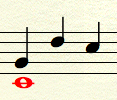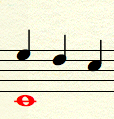Non-Chord Tones
If you’re versed in a bit of basic harmony, there’s no doubt that you’ve tried to assign Roman numerals to a piece of music. The basic premise is that you try to account for every note – each note must belong to a chord.
This ideal works really well for things like simpler Bach chorales and basic compositions, but it often fails when looking at more complex music. At some point, you’ll have to decide what tones really belong to the chord, and what are non-chord tones. A non-chord tone, as the name suggests is a note that doesn’t belong to a chord, it’s decoration. Depending on the harmonic rhythm of a piece, there might be just a few non-chord tones or several.
If the harmony changes every beat, that leaves little room for non-chord tones. But a piece that has a harmony that spans a measure leaves a lot of space for ornamentation of the chord tones.
Types of Non-Chord Tones
-
Complete Neighbor Tones
As the name suggests, a neighbor tone is just non-chord tone adjacent to a chord tone. The term complete implies after the neighbor tone, the line returns to the original pitch. These come in tow varieties: upper and lower.

Upper

Lower -
Incomplete Neighbor Tones
An incomplete neighbor tone is a tone adjacent to a chord tone, but not on both side. It’s easier to see in some musical examples. Assume a harmony of C major (chord tones=C E and G). In both examples D is an incomplete neighbor tone.

Incomplete Neighbor Tone (ex. 1)

Incomplete Neighbor Tone (ex. 2) Like the complete neighbor tones, incomplete neighbors can come in upper and lower varieties.
-
Passing Tones
A passing tone fills the space between two chord tones. Assume a harmony of C again (C E and G as chord tones); the D is a passing tone in both cases.

Passing Tone (ex. 1)

Passing Tone (ex. 2)
There are No Rules
There are not any rules that really govern the use of non-chord tones, and composers rarely concern themselves with rules anyway. Any of the above can be mixed or used freely creating complex melodies and textures.
The real point of this post is to make you aware of some types of non chord tones – to give you a way to explain them. In part 2, I’ll talk about a very specific non-chord tone that has a big impact on interpretation.

Shane
Wow… That’s some serious brain teasers right there 🙂 it will take a while to set in.
How do you come up with such cool technical info, love ya work:)